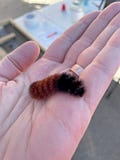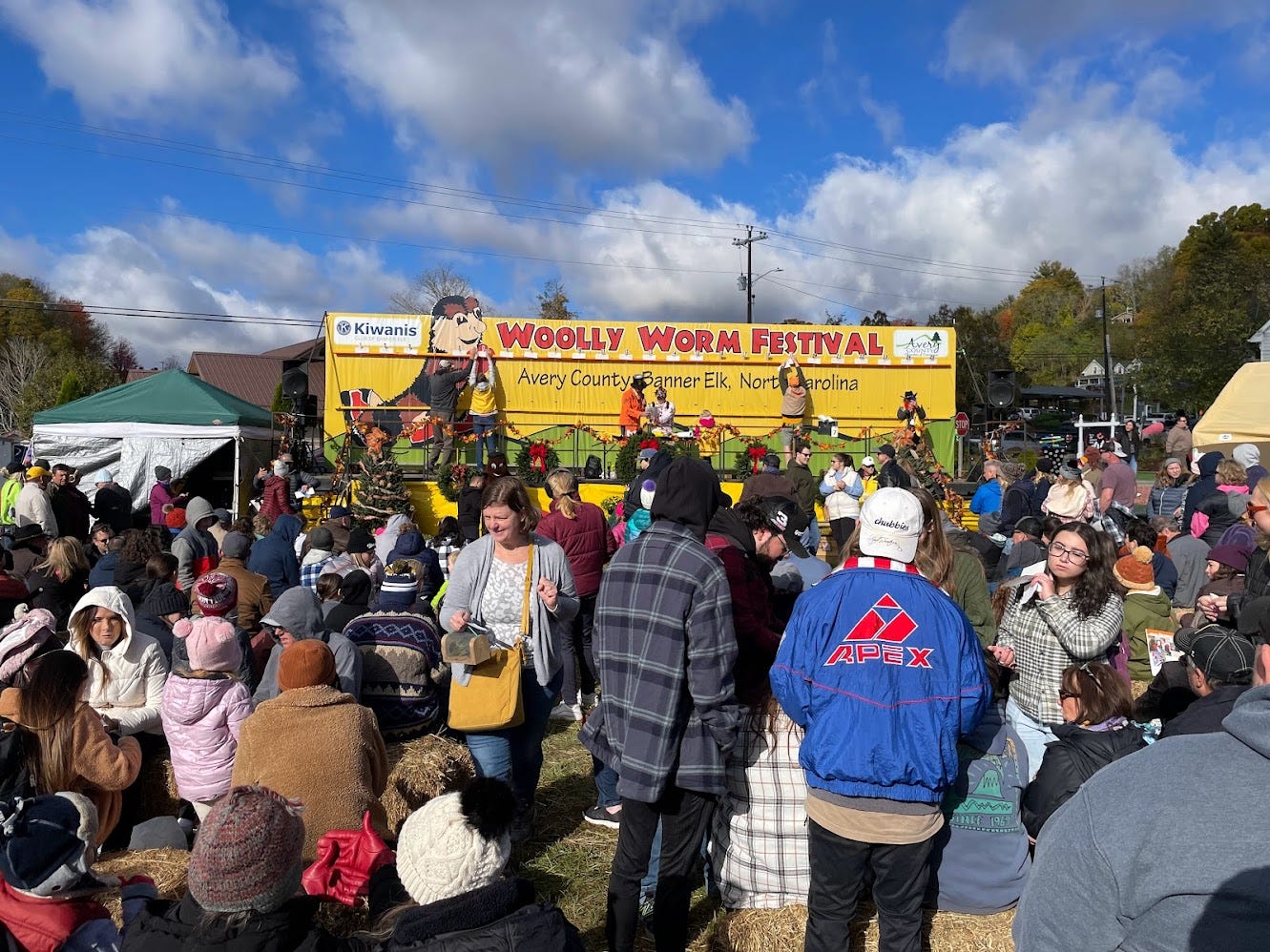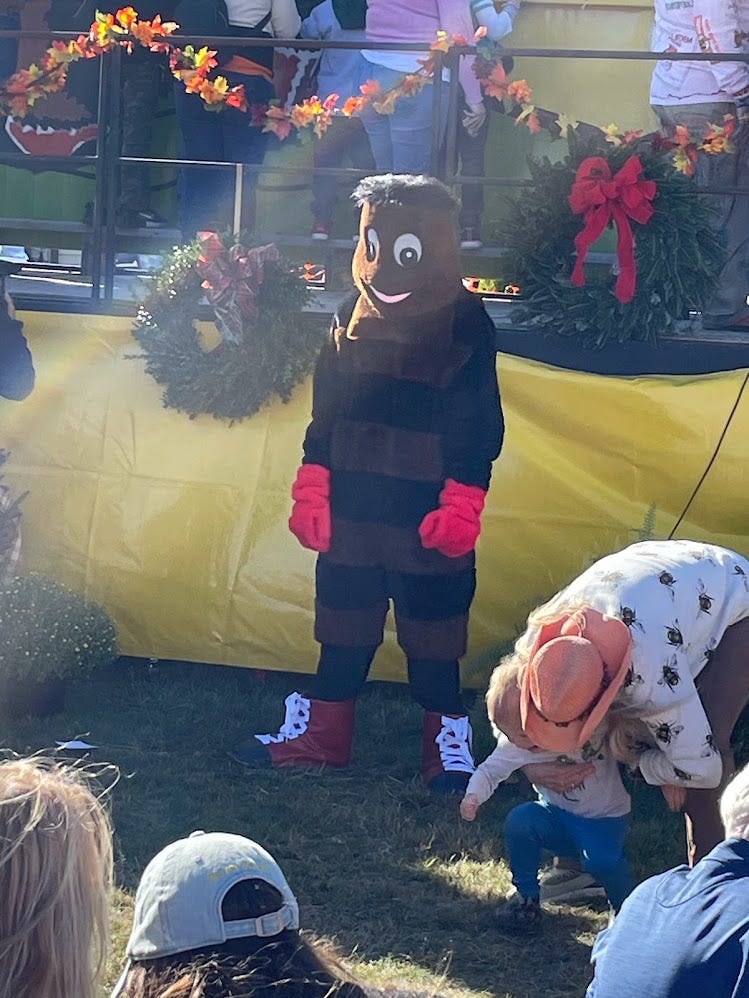Long before charismatic meteorologists stood in front of green screens on the evening news, people predicted the weather using a plethora of nature’s cues. Animal behaviors and vocalizations provide clues about upcoming weather events and seasonal changes.
Most importantly, people yearn to understand the unpredictable whims of winter. Thicker fur, increased feeding, food gathering, and food storage for critters like birds and various rodents, are all examples of wildlife predicting an especially cold or snowy winter. Perhaps the most famous example is the groundhog who informs us if spring will come early each year.
I believe there is a winter weather oracle that rivals Puxataweny Phil- the banded woolly bear. Also called the hedgehog caterpillar and the woolly worm (although they are not worms), these humble Pyrrharctia isabella caterpillars vary a lot in appearance, although most display some combination of black and reddish brown.
The caterpillars overwinter as larvae, then metamorphose into Isabella tiger moths in the spring. The moths are furry also, with a golden, muted tangerine hue, and black speckles on their wings and in a vertical line down their abdomen. Tiger moth researcher, William E. Connor wrote that people “around the world have been unable to resist the charms of the tiger moths.” Indeed, they are beautiful- one of those critters that we undoubtedly overlook hundreds of times without a clue as the to wonder we’re missing as we rush past the party at the porch light and through the threshold, closing the door ‘to keep the bugs out.’
Every year, people keep their eyes peeled for these fuzzy larvae as the leaves begin to change, curious to see what winter will have in store. Most simply, the thickness of the brown band in the center is said to predict the winter weather. In some variations on the lore, the fuzziness of the woolly worm is also taken into account. In others, the color sections indicate how weather will progress through the winter, with colors near the head symbolizing the beginning of the season. In general, black indicates a cold, harsh, snowy winter while brown foretells milder weather.
Was it true? I had to know more. On the third weekend of October 2023, a friend and I traveled to Banner Elk, North Carolina to attend the 46th annual Woolly Worm Festival. According to the festival’s website, the idea for the event originated in the 1970’s with a fellow named Jim Morton, who was working on including a winter forecast in Mountain Living Magazine. He made his prediction based on the first woolly worm he found, but then encountered another with completely different coloration. Instead of letting his subsequent observation lead to doubt about his initial prediction (or, apparently, the efficacy of the whole endeavor), he decided that there needed to be a formal way of deciding which worm to ‘read’ for the results. The first festival was held in 1978, and it has only grown since then, adding more craft vendors, food trucks, and live performances each year. Now, more than 20,000 people attend the two-day event each year “because racing Woolly Worms is a total blast!”
It felt like at least 20,000 people were in attendance when we entered the festival into a crowd of the caterpillar curious. Festival goers seemed to take over the entire small town in North Carolina’s ski country.
We quickly made our way to the main stage to experience our first ever woolly worm race. People stood in long lines to register their worms and receive their assigned heat number. There was a stage with a large, yellow backdrop from which the three-feet long strings were strung. A total of twenty-five strings allowed twenty-five worms to race during a single heat. At the end of each heat, one lucky winner would receive a blue ribbon and $25. Names of the competing worms were clipped above each string so the audience could cheer for the worm with the cleverest name. Some of our favorites from the day included: Free Woolly, Woolly Wonka, Luke Stringwalker, Obi Worm Kenobi, Fastest and Furriest, Moonshine, Mufasa, and Bless Your Heart.
“We’re racin’ woolly worms in the beautiful high country!” an announcer in a bright orange suit and a black top hat declared.
Heat 7 was just getting started when we approached the stage.
“The louder you cheer, the faster they race!” he shouted as ‘Walk Like An Egyptian’ blasted from the speakers.
I had my doubts. The stage, booming with shouting people and blaring music, was a far cry from the cozy interior of a rotting log.
“Worm down! Worm down” the announcer yelled into the microphone.
The crowd was too thick to see which individual worm had fallen from its string, dashing someone’s hope for victory.
Three judges were spread out on the stage in vests that said ‘Woolly Worm Festival Official’ to monitor race participants, point at worms in the lead, and blow their whistles when the first place worms reached the finished line. In this race, Woollburt in lane 24 was declared the winner.
“You will not find this kind of excitement anywhere else- not even NASCAR! At least not for eight dollars!”
Later on, we ran into Woollburt’s owner, a woman named Karen from South Carolina.
“Where did you get Woollburt?” I asked.
“I bought him here! He was actually my 5th choice,” she explained.
Woolly worms are collected from the surrounding area by Banner Elk Elementary students in the week leading up to the festival and sold for a few dollars each to race participants. Karen explained that all the worms she picked up from the plastic bins immediately curled into a ball in her hand.
According to University of Maryland entomologist, Dr. Michael J. Raupp, woolly worms curl into a ball when threatened. Some researchers even use this defense behavior to define survival in their studies. So, the woolly worms who act shy when handled are actually exhibiting a healthy defense response even though they are perceived as less likely to win a race up a string. Woollburt ended up proving himself- and proving Karen wrong- in the first heat, but the semi-final didn’t go so well.
“He froze up!”
Karen’s choice of words hinted at an incredible winter weather adaptation of the species that scientists study to better understand freeze-resistance in animals. Whether or not the festival attendees know it, woolly worms spend the winter tucked under the leaf litter as the conditions in their environment freeze and thaw around them. Inside their tiny bodies, a ‘cryoprotectant’ called glycerol protects them from becoming solid wormsicles and increases their chances of surviving to moth-hood.
Despite her disappointment, Karen paraded her ephemeral champion around the festival grounds in a plastic container with a neon green lid from which Woollburt’s prize ribbon fluttered. Had Woollburt won the whole thing, it would have foretold a mild winter because the majority of his midsection was brown.
Each race took just a couple of minutes, and while many worms never moved much, there were always a few who rather quickly ascended the string, sometimes pausing to let another worm take the lead. Occasionally one stopped and turned around to head back to the starting line represented by a small black dot.
What does make the worms climb faster? Does blowing on them help, like one little girl hoped as she huffed and puffed as her racer ascended the string? Is there anything people can do to increase their chances of winning? To what degree does potential success have to do with science versus superstition, whether understood by race participants or not?
In my research I found no satisfactory information on the locomotory behavior of woolly worms, although I have observed many hauling fuzz across the road on a sunny fall day. I thought it would be easier to find definitive answers to my questions about this species given its popularity. My research dead ends are a great reminder that there is still so much we don’t know about so many of our fellow animals, especially the ‘creepy’ and crawly ones.
After watching a couple more heats, we bought some hot apple cider and had fun browsing the vendors that sold everything from wood-burned Christmas ornaments to crocheted octopuses to stained glass window hangings. At a booth called ‘Woolly Worms and Stuff,’ we observed plastic bins full of live worms available for purchase. They crawled around among dead leaves, lichen-covered sticks, and pieces of wilting iceberg lettuce. Other vendors sold hand-painted wooden boxes to keep them in or little plastic containers on strings so kids could wear their racing worms around their necks. Some people simply carried theirs around in tiny paper cups- the kind you might use for mouthwash- until it was their turn to race.
KT and I returned to the stage after lunch (which included a chocolate cupcake dessert with a woolly worm in icing on the top) to watch the last six races before the grand finale. We sat atop bales of hay, sipping iced hot chocolate and shielding our eyes from the sun.
A little girl with a worm named Pinky won heat 54. She looked a little bewildered by the whole experience. Her older cousin, with a gleam in his eye, pocketed her $25 prize money right there on stage in front of everybody. Over time I observed for myself what the festival’s website suggested- children seem to win more races than adults. Those winners included at least three Floridians, and I was surprised to learn that so many people from my home state traveled to North Carolina for the festival.
To tunes as diverse as ‘Pretty Young Thing,’ ‘Turkey in the Straw,’ and Aretha Franklin’s ‘Respect’ the worms raced while Merryweather the costumed mascot danced and pumped his red-gloved caterpillar fists in the air. The crowd thickened as the championship race drew near.
At the conclusion of each race, the announcer said, “If you don’t want your worm, put it in the bin. We take all these worms back to the wild here locally.”
I was relieved of a mild, lingering anxiety about the fate of the reluctant racers.
Finally, after 56 heats and multiple semi-finals with eight worms each, seven finalists competed in the championship for a $1,000 prize and the honor of predicting the upcoming winter’s weather. ‘Let’s Get Ready to Rumble’ played as the racers took the stage for the last time. Then, the worms were off. Jack took an early lead, but Jeffery and Stupefy weren’t far behind. The cheering intensified as Jeffery took a 5 worm-lengths lead, and the whistle blew soon after to declare him the winner. The whole thing was over in just one minute, but Jeffrey, a real overachiever, decided to keep crawling across the top of the backdrop that held the strings.
“He passed the end zone and just kept runnin,’” said one announcers, “We should have written STOP up there!”
They called up the Woolly Worm Doctor, a man in a lab coat, to inspect Jeffrey and declare him ‘legal’ before the prediction was read. He inspected the worm with a pair of surgical magnifying glasses to check for PEDs (performance enhancing drugs).
“We’re lookin’ for singed hair, woolly growth hormones, illegal substances…”
There was laughter.
And a pause.
“Legal worm!” he declared.
As the crowd cheered, I mulled over whether the implication that some people color or otherwise ‘enhance’ their worms was a joke or based on past debauchery.
Jefferey was then passed to Tommy, the seven-feet, two-inches-tall ‘worm whisperer.’ The champion caterpillar’s thirteen body segments were read separately for a precise week-by-week prediction of weather conditions using historic average temperatures for reference.
“This is scientific!” the announcer assured the expectant audience.
Tommy referred to four color options: black (very cold and snowy), amber (colder than average), fleck (cold with frost or light snow), and light brown (warmer than average). A giant version of a children’s stacking toy mimicked the segments of the worm. Each time he called out a new color, another man on the stage twisted large discs into to represent each segment for the crowd to see. The black segments got a couple of very loud cheers from folks who I can only assume were hoping for a good ski season at nearby Beech and Sugar Mountain.
“It’s hard to read this woolly worm- it will not stop crawling around!”
The announcers shared that winter weather predictions from the festival have been 86.5% accurate since the event’s first year. Apparently, it would be even higher but a couple of years, in the final race, the worm’s human got so excited as they approached the top of the string that they knocked their worms off and sabotaged their own success.
“And we’ll finish up with some snow!” Tommy said of Jeffrey’s black rump.
While I wasn’t sure how winter would actually play out in North Carolina’s High County, I had to agree with the festival website’s claim that: “There is no other experience in life that can produce the absurd euphoria that comes from cheering for a caterpillar to climb a string. It is so indisputably ridiculous that it is completely liberating!”
KT and I spent the day thoroughly entertained, cheering along with the crowd for the worms with our favorite names. I had no doubt, though, that the same question was lingering in the back of both of our minds. Like a tiger moth to a porch light, the scientist part of our brains wondered: Was there any evidence to back this stuff up?
According to the National Weather Service website, the color patterns of woolly worms are more likely representations of their diet and their age. Therefore, the colors are better indicators of growth during their previous molt than about anything to do with the future. A healthy, growing caterpillar becomes more orange with each molt. It turns out Woollbert was a happy old worm!
Later that evening KT reflected on the day’s experience: “What stood out to me the most was how into it people got. They traveled from all over the region and across state lines to get there. As someone who has never done anything like that, it was delightfully bizarre to me.”
We then had a nerdy discussion about something else both of us found ourselves pondering throughout the day: What is this experience like for the worms?
“Do they like to be picked up and touched? What’s it like to be contained around someone’s neck all day? Do they hear vibrations when they’re on the string and people clap? What makes them go fast or slow or decide to turn around? Maybe no one knows and that’s what makes it magical.”
In the end, it doesn’t seem to matter much who the winning worm is or whether the predictions hold up through the coming season. What matters is the sense of community cultivated at the festival and the charm of connecting with nature in such a unique and regionally specific way. It is clear that the folklore of the woolly worm’s weather predicting capabilities carries more weight in Appalachian culture than the science (or lack thereof) surrounding it.
“If there was a scientist there telling people facts, that would take away the ritual and the fun of it for the humans,” KT said.
And yet, I do think the festival could use a little bit more education about woolly worm ecology. For example, if people choose to take the woolly worms they purchase home, they should at least be given care instructions that include the importance of these local critters overwintering outside to ensure healthy metamorphosis come spring. I believe we should strive to know and love the individual critters themselves as much as we enjoy the festival experience and the folklore that inspires it.
To this point, we drove down the mountains with a new sticker proudly displayed on my bumper: “I love woolly worms (and I hope they like me too)!”
Note: The festival had to pivot to an online event (Woolly Worm Webfest) this year because of Hurricane Helene. Organizers are happy to keep the tradition going and hope to be back again next year!





